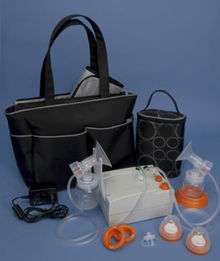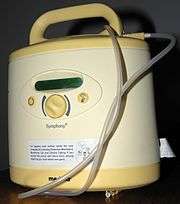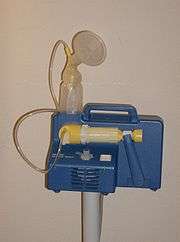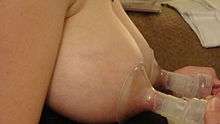Breast pump




A breast pump is a mechanical device that extracts milk from the breasts of a lactating woman. Breast pumps may be manual devices powered by hand or foot movements or electrical devices powered by batteries or electricity from the grid.
History
On June 20, 1854, the United States Patent Office issued Patent No. 11,135 to O.H. Needham for a breast pump.[1][2] Scientific American (1863) credits L.O. Colbin as the inventor and patent applicant of a breast pump.[3] In 1921-23, engineer and chess master Edward Lasker produced a mechanical breast pump that imitated an infant's sucking action and was regarded by physicians as a marked improvement on existing hand-operated breast pumps, which failed to remove all the milk from the breast.[4] The U.S. Patent Office issued U.S. Patent 1,644,257 for Lasker's breast pump.[5] In 1956 Einar Egnell published his groundbreaking work, "Viewpoints on what happens mechanically in the female breast during various methods of milk collection".[6] This article provided insight to the technical aspects of milk extraction from the breast. The Egnell SMB breastpump designed through this research is quite robust and many pumps are still in operation today over 50 years after publication.
Archaeologists working at a glass factory site in Philadelphia, Pennsylvania, excavated a 19th-century breast pipe that matches breast pumping instruments in period advertisements.[7]
Mechanical properties
Mechanically, a breast pump is analogous to a milking machine used in commercial dairy production. A misconception is that the breast pump suctions milk out of the breast. A breast pump's job is to trigger the milk ejection response or letdown. Pumps achieve this by using suction to pull the nipple into the tunnel of the breast shield or flange, then release, which counts as one cycle. Thirty to sixty cycles per minute can be expected with better-quality electric breast pumps. The breast pump is not as efficient at removing milk from the breast as most nursing babies. Most manufacturers have multiple sizes of nipple tunnels available. These tunnels range in size from 24mm to 36mm.
There are several types of pump mechanisms. Piston pumps draw a piston through a cylinder to create suction. These are generally considered top-of-the-line units. They have characteristics of low speed, high reliability, low noise, and long life. Rotary vane pumps use a cam with retractable vanes to create suction. These rotary vane pumps are not widely used anymore. Fast diaphragm pumps use a diaphragm that is acted on by a lever, with thousands of cycles per minute. They operate at higher speed and are usually noisier. Slow diaphragm pumps use a large diaphragm operated by a cam or lever to generate suction with each stroke. Pumps have also been designed that use venturi effects powered by a faucet or water stream, wall suction in hospitals, or pumps powered by oral suctioning.
Efficiency
A report in 2009 on research done at Stanford University showed the correlation of various factors with mature milk production in mothers of preterm babies (born before the 31st week of gestation).[8] The research found that using massage techniques in addition to a breast pump (a technique they call "hands on pumping", or HOP), along with several other factors, was highly correlated with higher milk production. The study found that the mothers who used massage techniques and hand expression more than 5 times a day in the first 3 days after birth could increase their milk production 8 weeks later, and that, by combining this with HOP, milk production increased 48% even without increased pumping. The authors of the report produced a video which shows the technique and states that this technique is good for both mothers of premature infants as well as mothers that return to work or pump for other purposes.[9]
A second article on the same study found that the combination of the HOP techniques increased the fat content of the milk expressed.[10]
Milk collection and storage
Most breast pumps allow direct collection of pumped breast milk into a container that can be used for storage and feeding. Many pumps are proprietary, and you must use the manufacturer's bottles for this purpose. Other manufacturers allow for adapters to fit a variety of types and sizes of bottles, which allows more selection and the ability to change collection and feeding system based on mothers' and babies' preferences.
The expressed breast milk (EBM) may be stored and later fed to a baby by bottle. Expressed milk may be kept at room temperature for up to six hours (at 66-72 degrees Fahrenheit, around 20 degrees Celsius), refrigerated for up to 8 days, or frozen for 12 months in a deep freeze separate from a refrigerator maintained at a temperature of 0 degrees Fahrenheit, −18 degrees Celsius. Expressed milk may be donated to milk banks, which provide human breast milk to premature infants and other high-risk children whose mothers cannot provide for them.[11]
Reasons for use

Women use breast pumps for many reasons. Many women use breast pumps to continue breastfeeding after they return to work. They use the pump to express breast milk, which is later bottle fed to their child by a caregiver. A breast pump may also be used to stimulate lactation for women with a low milk supply or those who have not just given birth. However, it is important to note that the amount of milk a woman is able to pump should not be compared to how much milk a baby can get; efficiency greatly varies.[12] A breast pump may be used to relieve engorgement, a painful condition whereby the breasts are overfull, possibly preventing a proper latch by the infant. A mother may also choose to pump exclusively if her baby does not latch properly, is hospitalized after birth, or cannot nurse for physical reasons (such as cleft palate). If the mother needs to take medication that affects the breast milk and may be harmful to the infant, which is a very rare instance, the mother may "pump and dump" the breast milk to keep up her milk supply during the time period that she is on the medication and may resume nursing after the course of medication is completed. *Consult Wendy Jones regarding information on safety of specific medication while breastfeeding before taking any advice re ability to feed on medication/need to pump/dump* Pumping may be desirable to continue lactation and its associated hormones to aid in recovery from pregnancy even if the pumped milk is not used. [13][14]
In a 2012 policy statement, the American Academy of Pediatrics recommended feeding preterm infants human milk, finding "significant short- and long-term beneficial effects," including lower rates of necrotizing enterocolitis (NEC). [15] When infants are unable to suckle, mothers can pump if they wish their babies to be fed with the mothers' own milk.[16] Donor milk may be available from milk banks for babies who are not able to receive their mothers' milk. Expressing milk for donation is another use for breast pumps.[17]
Pressure range and safety

Egnell in 1956 established a 220 mmHg safe maximum for automatic cycling pumps. There have been reports though of sensitive breasts and nipples at much lower pressures. Hartman P, et al. in the 2008 study[18] showed that the maximum comfortable vacuum enhances milk flow and milk yield.
Manual breast pumps
Manual breast pumps are operated by squeezing or pulling a handle in a repetitive fashion, allowing the user to directly control the pressure and frequency of milk expression. Though manual pumps are small and inexpensive, they can require significant effort and can be tiring because the user provides all the power. They also allow for only one breast to be pumped at a time. This style is recommended for infrequent usage such as when a woman is away from her baby for a single feeding. These pumps may not provide sufficient stimulation and emptying of the breast. It is recommended that "bicycle horn" style manual pumps not be used. Though cheap, they can damage breast tissue and harbor bacteria in the rubber suction bulb, which is difficult to clean.[19][20][21]
Foot-powered breast pumps use the same collection tubing and breast horns as electric breast pumps, but are powered by a foot pedal. This eliminates the work of pumping by hand or the need for finding an electrical outlet with privacy.[22]
Electric breast pumps
There are two types of electric breast pumps, hospital grade and personal use pumps. Hospital grade pumps are larger and intended for multiple users. Personal use pumps are smaller and generally intended for one user. Electric breast pumps are powered by a motor which supplies suction through plastic tubing to a horn that fits over the nipple. The portions of the pump that come into direct contact with the expressed milk must be sterilized to prevent contamination. This style provides a lot more suction, making pumping significantly faster, and allows pumping of both breasts at the same time. Electric breast pumps are ideal for when a mother will be pumping daily. Electric breast pumps are larger than manual ones, but portable models are available (e.g. in a backpack or shoulder bag) that allow the mother to transport the pump. Some manufacturers have battery packs or built in batteries to allow portable operation of the pumps. Some electric pumps allow for multiuser operation, requiring only an accessory kit for each user.[23]
Electric breastpumps can also be rented. Rental pumps are many times recommended for mothers or babies with medical problems such as a premature infant or mother on medication that contraindicates breastfeeding. Rental pumps will generally sustain a mothers milk supply better than personal use pumps. Lactation consultants may assist in selection and training in use.[23]
Some breast pumps are designed to be part of a "feeding system" so that the milk storage portion of the pump is the baby bottle used to feed the infant. This allows the milk to be collected in the same bottle that will feed the baby eliminating the need to transfer breastmilk. Freezable breastmilk storage bags are available that connect directly to some breast pumps and can then be used with disposable bottle feeding systems.
Open collection systems vs. closed collection systems
The plastic tubing and horn of an electric breast pump are commonly referred to as the collection system. When this style of breast pump was originally developed, the pump's suction was supplied through the collection system tubing. This type of collection system design is now referred to as an open system.
Most electric breast pumps feature an open collection systems. A closed collection system has a barrier or diaphragm that separates the pump tubing from the horn. In this design, the suction of the pump motor lifts the diaphragm to create a vacuum within the collection system to extract milk. An open system allows for the free passage of air/suction. Bacteria and viral filters may be present to prevent any contamination or overflow into pump motor. The pump mechanism motor's suction is directly passed to the mothers breast versus indirectly with closed diaphragm systems.[24]
Open collection systems allow for more flow of air/suction and may be more effective for most women. These systems can compensate better for different tissue elasticities and sizes and shape of the breast. When an open collection system is used, the pump’s suction can cause milk to overflow it into the collection system tubing, which may lead to milk particles being drawn into the pump motor. If milk leaks into the pump's tubing, the tubes should be washed, sterilized and air-dried prior to using the pump again. Failure to thoroughly clean collection tubing may lead to mold growth within the tubing. Some models of pumps have bacteria and overflow filters which prevent milk from entering the tubing. [24]
A subtype of the open collection system is the single user suction source. These type of pumps have added hygienic benefit of all the parts that generate the suction or come in contact with breast milk stay with the mother. The parts that generate the suction are external to the pump, and can be removed, providing outstanding protection against cross contamination. These pumps are rental or hospital grade breast pumps. Using a pump of this type virtually eliminates the chance of cross contamination of the pump from mother to mother.
The diaphragm in a closed system eliminates the possibility of milk being able to overflow into the pump tubing. Because milk is not exposed to the pump motor, closed collection systems are marketed as more hygienic than open collection systems.[24] It is important to clean the diaphragm as condensation or milk may reach this part causing bacterial contamination. If the diaphragm is contaminated this may defeat the purpose of the closed system. The barrier in a closed collection system breast pump is marketed as preventing outside air from contaminating the expressed breastmilk in the collection bottle, which preserves the milk’s purity. The diaphragm may limit the amount of air/suction that can be used to extract milk from the breast. It may also not be able to compensate for larger shield sizes as well. There are no studies comparing the open versus closed system design. Most information is marketing materials without studies to back them up.
See also
- Lactation suppression
- Wet nurse, a woman who feeds a baby who is not her own
References
- ↑ Breast Pump, Patent No. 11,135 Retrieved on 2008-12-14.
- ↑ Breast Pump, Patent No. 11,135 Google Patents abstract
- ↑ Scientific American, Vol. 8, No. 4, January 24, 1863.
- ↑ Edward Lasker, Chess Secrets I Learned from the Masters, David McKay, 1951, pp. 249-50. Lasker relates that he designed his device at the urging of pediatrician Dr. I.A. Abt of Chicago, and that Abt and obstetrician Dr. Joseph DeLee considered it a marked improvement on existing hand-operated breast pumps. Dr. DeLee considered the machine indispensable for any hospital that did maternity work. Id.
- ↑ Patent No. 1,644,257 issued by U.S. Patent Office
- ↑ 1: Sven Lakartidn. 1956 Oct 5;53(40):2553-64.Links [Viewpoints on what happens mechanically in the female breast during various methods of milk collection.] [Article in Swedish] EGNELL E.
- ↑ White, Rebecca. "Symbols of motherhood: breast pipe and nursing bottle. Artifact of the month August 2013.". Philadelphia Archaeological Forum. Retrieved 2 August 2014.
- ↑ J. Morton et al. "Combining hand techniques with electric pumping increases milk production in mothers of preterm infants" J Perinatology (2009) 29 757-764
- ↑ http://newborns.stanford.edu/Breastfeeding/MaxProduction.html
- ↑ J Morton et al. "Combining hand techniques with electric pumping increases the caloric content of milk in mothers or preterm infants" J Perinatology (2012) 32 791-796
- ↑ Henry, Shannon (2007-01-16). "Banking on Milk". washingtonpost.com. Washington Post. Retrieved 2015-10-17.
- ↑ Breastfeeding Myths Archived April 5, 2013, at the Wayback Machine.. Boob Baby. Accessed on May 16, 2013.
- ↑ Johns12, Helene M; Forster, Della A; Amir1, Lisa H; McLachlan, Helen L (2013-11-19). "Prevalence and outcomes of breast milk expressing in women with healthy term infants: a systematic review". BMC Pregnancy and Childbirth. 13 (212). doi:10.1186/1471-2393-13-212.
- ↑ Rasmussen, Kathleen M.; Geraghty, Sheela R. (August 2011). "The Quiet Revolution: Breastfeeding Transformed With the Use of Breast Pumps". Am J Public Health. 101 (8): 1356–1359. doi:10.2105/AJPH.2011.300136.
- ↑ American Academy of Pediatrics, Section on Breastfeeding (2012). "Breastfeeding and the Use of Human Milk". Pediatrics. 129 (3): e827–e841. doi:10.1542/peds.2011-3552. PMID 22371471. Retrieved 2013-07-25.
Meta-analyses of 4 randomized clinical trials performed over the period 1983 to 2005 support the conclusion that feeding preterm infants human milk is associated with a significant reduction (58%) in the incidence of NEC.
- ↑ "Feeding Your Baby in the NICU". March of Dimes. Retrieved 2014-03-14.
- ↑ "Milk Donation FAQ". International Breast Milk Project. Retrieved 21 September 2015.
- ↑ Hartman, P, et al. Importance of Vacuum for Milk Expression Breastfeeding Med 3(1) 11-19
- ↑ "Breastfeeding and Pumping Accessories". Breastfeeding Made Easier At Home And Work. Womenshealth.gov. Archived from the original on 14 Jan 2009.
- ↑ "Pumping and milk storage". Breastfeeding. Womenshealth.gov. 1 August 2010.
- ↑ Corley, Heather. "Before You Buy A Breast Pump". About.com. Retrieved 9 March 2012.
- ↑ A US patent 5304129 A, Suzanne E. Forgach, "Pivotable foot operated breast pump", issued 1994-04-19
- 1 2 "Buying or Renting a Breast Pump". fda.gov. Food and Drug Administration. Retrieved 21 September 2015.
- 1 2 3 Shu., Dr. Jennifer (2011-06-13). "Is a used breast pump safe?". CNN. Retrieved 21 September 2015.
External links
| Wikimedia Commons has media related to Breast pump. |
- La Leche League International breastfeeding/pumping support site
- Collecting and storing breastmilk – California Department of Health Services
- Storing Breast Milk/Thawing Frozen Breast Milk – City of Toronto Health Department
- Human Milk Storage Information – La Leche League International
- Hands on Pumping – Stanford University